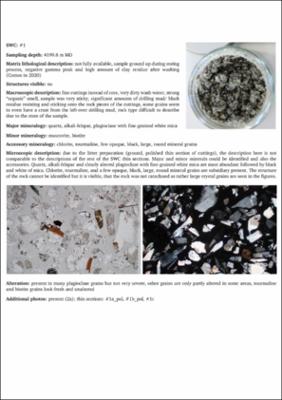Side wall cores of the United Downs Deep Geothermal Power Project, Cornwall: general characterisation and results of lab-scale chemical stimulation of fractured granite reservoir samples
Beschreibung
In a fault-related deep granitic reservoir located in Redruth, Cornwall (UK), a geothermal doublet-system (United Downs Deep Geothermal Power Project, UDDGP) was completed in June 2019. The development of the geothermal resource of the high-heat-producing granites beneath SW England (Cotton et al., 2020), is the major goal of UDDGP. In the production well UD-1 with a depth of 5275 m (MD), up to 190°C have been measured. The doublet-system (UD-1 and the injection well UD-2 with a depth of 2393 m MD) is aligned vertically, so that both wells penetrate the large-scale Porthtowan Fault Zone (PTF), acting as the geothermal reservoir linking the wells. The PTF is located in the Carnmenellis Granite, the largest onshore pluton of the Cornubian Batholith. An in depth understanding of the geothermal reservoir is needed to create a basis for reservoir modelling and to allow for an adequate configuration and dimensioning of the geothermal system including the geothermal power plant. Within the scope of the EU funded MEET project (EU-H2020, GA no. 792037), which aims to support and develop new technologies, approaches and potentials for exploration and exploitation of enhanced geothermal systems (EGS), 20 side wall cores (SWCs) were obtained in UD-1 at selected depths between 4200 m MD and 4900 m MD to petrographically and petrophysically analyze the granitic reservoir rock.
The rock characterization laboratory workflow includes petrophysical measurements followed by a mineralogical and geochemical analysis to define and characterize the properties and composition of the relevant granite types and fracture and fault zones. The cores were analyzed for particle and bulk density, porosity, permeability, thermal conductivity, thermal diffusivity including calculated heat capacity and ultra-sonic wave velocities. Thin sections were analyzed for mineralogical composition and texture, intensity of hydrothermal alteration, fractures and the general condition of the rock. Furthermore, XRD, ESEM, XRF and ICP-MS analyses were performed to provide information about the mineral assemblage, bulk geochemistry and the resulting radiogenic heat production. For the preparation of a reservoir-scale chemical stimulation, acidification experiments under in-situ conditions (150°C and 17.5 MPa) were conducted by Core Flooding Tests (CFTs) on seven selected SWCs using customized acid systems for stimulation of granitic rocks (Lummer et al., 2018). The CFTs resemble the planned chemical stimulation of the reservoir and is an experiment for the evaluation of the effectiveness of a potential chemical treatment of the reservoir rock to reach sufficiently high flow rates to allow for an economic productivity. The SWCs consist to major parts of hydrothermally-altered granite, so that the results of the experiments can be transferred to altered faults zones and fractures of the PTF. According to the XRD results, the Carnmenellis granite can be classified as monzogranite, while the altered SWCs are plotting as quartz-rich granitoides, monzogranites, granodiorites, and even as tonalities and quartz diorites/ -gabbros/ -anorthosites (according to Streckeisen) for the highly altered samples. The XRF results suggest a more uniform composition so that the samples plot in the granite, granodiorite, quartz monzonite and only one highly altered sample in foid monzodiorite field of the TAS diagram. The CFT results show a high efficiency of the customized acid system with resulting permeability enhancement factors between 2 and up to >100, depending on the initial permeability of the specimens and dissolution of secondary minerals during the experiments.
Provided material of this dataset:
- D5.5_Appendix_3_P32MEET data table: overview of the samples, petrophysical measurements (including derived calculated parameters), results of XRD, XRF, ICP-MS, thin sections and core flooding test
- Characterisation of the 19 Side wall core samples with macroscopic and microscopic description including photos (PDFs)
- Photos of the 19 Side wall core thin sections (ZIP data file and list of inventory)
- Additional photos from the Side wall cores before and after the CFTs (ZIP data file and list of inventory)
- Excel table with ESEM data and material
- Excel table with and detailed CFTs data and material
Acknowledgments: The present work was put into practice at the Technical University in Darmstadt, at the Institute of Applied Geosciences, Department of Geothermal Science and Technology within the framework of the projects MEET and the United Downs Deep Geothermal Power Project in Cornwall, UK. We thank the laboratory staff and the project partners related to MEET/ UDDGP, to mention B. Lédesert, D. Scheuvens, J. Reinecker, R. Petschick and R. Shail.
Schlagwort
Enhanced Geothermal Systems;United Downs Deep Geothermal Project;Petrophysical Properties;Core Flooding Tests;Side Wall CoresDFG-Fächer
3.42-01 Geologie3.43-01 Physik des Erdkörpers
3.44-01 Mineralogie, Petrologie und Geochemie
URI
https://tudatalib.ulb.tu-darmstadt.de/handle/tudatalib/2926.2https://doi.org/10.48328/tudatalib-630.2
Zugehörige Drittmittelprojekte
EC/H2020 | 792037 | MEETSammlungen
Die folgenden Lizenzbestimmungen sind mit dieser Ressource verbunden:


